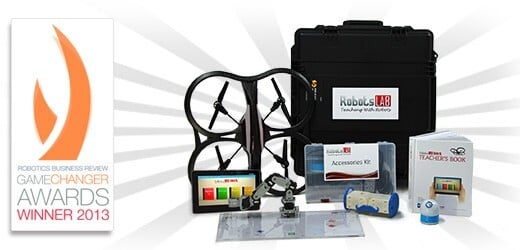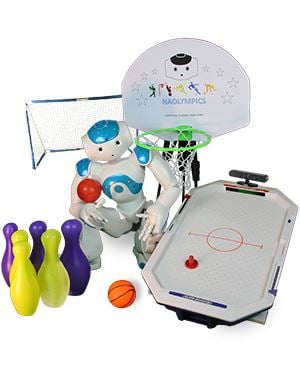Jeff: "We have a great show you for today. From RobotsLAB.com, we have Mr. Elad Inbar.
Elad, how are you today?"
Elad: "Hey, Jeff, thanks for having me. We're great here."
Jeff: "And how are things over at RobotsLAB today?"
Elad: "Perfect. Perfect. We have robots all around us. We're working with them, playing with them. Who can complain?"
Jeff: "And talk to us a little bit about RobotsLAB. When did it start? How did it start?"
Elad: "So I started the company back in 2007 in Israel, and I moved everything to the US in 2011. So we're based in San Francisco. We've created several education robotics programs and solutions for teachers. The idea is that we want to engage students with math and science and bring to life all kinds of concepts in math and science and show the students why these subjects are actually relevant to their lives, why they need to learn it. We've found that robots are the best way to do it because they are so visual, and students really love them. So this is what we're doing: engaging students with math and science using robots."
Jeff: "And RobotsLAB is certainly one of those leaders and innovators in stem technology. Why don't we back up a little bit and talk a little bit about what is STEM technology and STEM education?"
Elad: "Well, one of the teachers told me that STEM today is like the wild, wild West. Everyone can do whatever they want. There's nobody to enforce anything on that. We've found that to be very true. Teachers are trying to put their hands on the latest and greatest technology, but they're missing the curriculum behind it. So we see schools buying 3D printers and don't know what to do with them. And buying the best robots and other tools and, again, they don't know what to do with them. We've partnered with 14 teachers and a professor from UT Austin and we created a comprehensive solution for schools so they will be able to actually use this greatest and latest technology and actually engage students with them. So STEM is much more than just a buzzword. Especially now with the Common Core standards and blended learning. We have to show students that everything is connected: the Math, the Geometry to the real world, and they have to take Pre Calculus outside of the classroom and so on. We're just glad that we are able to do that."
RobotsLAB BOX
Jeff: "The website is RobotsLAB.com. Talk to us a little bit about what we can find on the website when we visit."
Elad: "So we have 4 different programs, and each one of them is designed to cover the S, the T, the E, and the M of the STEM. So for the Math component of STEM, we have the RobotsLAB BOX, which is a kit that comes with 4 different robots and a tablet that controls all the robots. Using this tablet, we can actually show them and teach the students all kinds of different subjects from Algebra 1 all the way to Pre-Calc including Geometry, Trigonometry, and Physics. So this is under the Math component of that. Under the Science component of that, we have the NAO, a humanoid robot. We've created a curriculum that we call NAO Olympics, in which the students need to program the robot to play all kinds of games like basketball, soccer, and air hockey. And they get to learn much more than just computer programming. They get to learn about trajectories. Just think about basketball. They learn about mass and force. They learn about Geometry and Trigonometry by playing soccer. They have to triangulate the robot and the goal. And they learn about the linear equations and angles by programming the robot to play air hockey and so on. So this is under the Science side of that. Under the Technology side, we have a program that we call STEM Bot 3D. It's actually a 3D printed robot. I have one with me here. This is a 3D printed robot. This is a very cute monster. It's really nice but if you think about it, the skeleton is actually 3D printed. So this is what they actually get to work with. The curriculum here actually walks them through the whole life cycle of a product. From designing, to 3D printing, working on the electronics, and eventually programming the robot. So this can actually show the students that 3D printers are much more than just for downloading cute penguins from the Internet and printing them. They can actually create a working robot and interact with this product that they've created. And then under the Engineering side of STEM, we have another program that we call Bioloid STEM. It's basically a kit where the students can build different robot models, they can program them, and they can actually create the software around that. And in this one, we teach them much more than just building robots. It's actually designed to teach them things like gear ratio, torque, all engineering concepts behind the robots. So this is what we're doing. Everything is basically educational robotics, and we cover the whole spectrum of STEM using robots."
NAO Olympics program
Jeff: "When we're talking about school districts looking to get into STEM and looking to make that jump into broader science and technology curriculum, what's the financial consideration that a school district has to take. I mean, in order to obtain one of those amazing robots, what do they need to do, how does it work, and is this something that a school building calls you? Or does a classroom teacher usually connect with you?"
Elad: "So on the district level, obviously we have packages that they can employ into several schools. most of our products are what we call shareable. So one teacher can use one day, and another teacher on another day. They can actually move them from even one classroom to another, so you can start in the math classroom, and the next day it can be in the physics classroom. And the following day, it can be in the geometry classroom. So you're not limited to one teacher or per classroom or something like that. So we're trying to be very cost efficient for the schools and make sure that they will be able to afford it. Every time we bring one of these robots to the classroom, we just see how students are totally engaged. There eyes are open and they react, "Whoa! What is this? What does it do? I want to work with it. I want to play with it." And that's the great thing about robots. It's a perfect tool for teachers. So in terms of how to get it, first of all, if you're going to any of the big educational conferences, we are there: from ISTE, NSTA all the way to NCTM, the math teachers conference where we're exhibiting in a conference show, in a conference every probably 3 or 4 weeks. We are booked up until September now. So you can meet us in each one of these conferences and put your hands on each one of these robots, and the tablet, and just start playing with them and get the idea of how it's actually engaging students."
StemBot 3D
Jeff: "Well, we certainly looking forward to seeing you this year in Atlanta at ISTE. I will be down there covering all the great action. Talk to us a little bit about how STEM relates to the workforce. I mean, a lot of students are getting into the science and technology classes. What advantages do those kids have once they finally graduate?"
Elad: So one of the things that we always put in mind is that STEM is not just a buzz word. This is something that profoundly changes the way we think about education and especially the career side of that. I mean, everyone says, "Career and college readiness." We all know what college readiness is, but what is career readiness? I don't know. To become a secretary. Is that a career or something like that? And we believe that the answer is no, especially today. We live in the digital era, so everything becomes data. Even if you're just doing a marketing job where you think that you don't need any experience in math and so on, it's just not true. Just running a campaign and measuring the results and making predictions on the future. These are all mathematical concepts, and we are trying to engage students earlier in their lives and actually show them how things that quadratic equations and linear equations actually can contribute to their future life. Another example: we have in one of our kits a robotic arm in which students need to work on the sine and cosine and arc length and all of the geometry and trigonometry behind it. The idea is, again, we want to show the students that later on, they're going to graduate, they're going to work in one of these factories. I don't know if you know but they're all running these robotic arms, and they have to understand how these arms are actually working and how to program them. What's the geometry around it? Down in California here there is a company called Tesla. They're manufacturing the electric car, and it's all automated. A bunch of robotic arms are actually manufacturing cars autonomously. If one of the kids want to be part of this future workforce, they have to understand how it actually works and what they need to do with it."
Bioloid STEM
Jeff: "You know, we've talked a little bit about the financial considerations, but can you talk to us a little bit about the infrastructure? If a classroom or if a school district is looking at moving into this technology field, what do they need to have already set up? I mean, Wi-Fi networks. Does it matter with these robots if it's Apple, Android, Windows-based, Google-based? What should they be considering before they contact you?"
Elad: "That's a great question because we heard this concern from our teachers. Many times they buy products and it just doesn't connect. It doesn't work in their classroom. So what we are doing is actually, we eliminated the need for any third party equipment except one: a projector or a smart board. We actually provide everything, even the tablet with all the lessons is included in the kit. So the teachers don't need anything. Just the kit. We even provide the dongle that connects the tablet to the projector, to the smart board. So seriously nothing. If they don't have a 3D printer, we can provide that. If they don't have a wireless charger, we don't require any Internet connection in our kits. We try to eliminate all these barriers to put this great technology into the classrooms. I had an amazing discussion with one of the principals just this week where he asked me why kids are so in love with robots. "What's in it?" We started talking and I really didn't think about it until this week. But if you think about it, if you a child. You are hammered by commands. "Do this, do that, wake up at this time, go to school, do your homework, go that way." So everyone is giving you instructions all day long. And when you get to put your hands on a robot, then the robot is not giving you any commands. You are actually commanding the robot to do something, which puts the child in the controller mode. This is a different phase in their lives because no one is actually telling them what to do. They are telling someone else what to do. So this is like a subconscious level. Really push kids to work with robots and to play with them. On top of the fun of flying helicopters and so on. So yeah. It's just like an amazing thing that we just realized here."
Jeff: "I was looking at some of your pictures there on your website and the Quadcopters looks like they're absolutely a blast to play with."
Elad: "Oh, yeah."
Jeff: Elad, thank you so much for spending time with us today. One more time tell us where we can find more information about the great work that you're doing."
Elad: "So the best thing will be our website: www.RobotsLAB.com, and you can find all the products over there. We have a blog that actually shares everything that we are doing, all the awards that we are winning, and the workshop, the professional development where we are running with teachers. Everything is basically over there on the website. If you want, you can look at our Twitter account, @TheRobotsLab. If you happen to be at one of these conferences, we'll be more than happy to give you some robots to play with."
Jeff: "Certainly look forward to seeing you out there at ISTE, and I'm looking now at your Twitter feed here. It says you guys were in the top 10 Ed Tech startup finalists at South by Southwest EDU? That's really, really amazing."
Elad: "That's right. That's next week, yeah."
Jeff: "Congratulations on that."
Elad: "Thank you. We're going to win, so...congratulate us when we win."
UPDATE: ROBOTSLAB WON SxSW competiton!!!
Jeff: "Well, my friends that wraps up another episode of The TeacherCast at Spotlight. I want to thank again our friends from RobotsLAB.com for coming on and sharing the great things they're doing in STEM education. There is of course many ways you can contact the show each and every week. You can find us on Twitter @TeacherCast. Leave us a voicemail at TeacherCast.net/Voicemail. Email us at Info@TeacherCast.net. And of course, subscribe to our many audio and video channels over at TeacherCast.net/ITunes and TeacherCast.net/YouTube. My name is Jeff Bradbury. Please join us next time for another great episode. I'll be back then. And until that time, keep up the great work in your classrooms and continue sharing your passions with your students."





